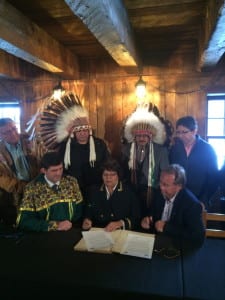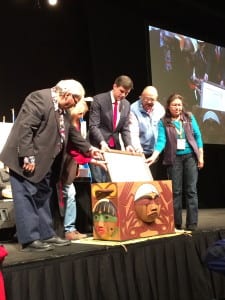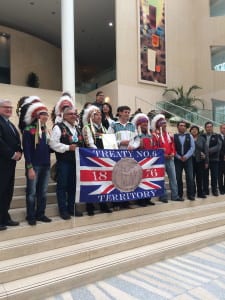A Year of Reconciliation
Last week marked the one year anniversary of the Truth and Reconciliation Commission (TRC) Final Event that was held in Edmonton. We were honoured to host such a significant event in our city and I know many Edmontonians were deeply affected by what they heard over those three days of testimony. I certainly was.
Residential schools traumas, and the intergenerational effects they’ve wrought on Aboriginal families, continue to be one of Canada’s most disturbing legacies; and in a city with one the largest urban Aboriginal populations, we’re impacted by that dark history even today.
I honestly didn’t know what kind of experience to expect when I agreed to be a TRC Honorary Witness. But the Survivors’ stories that weekend, and the friends and colleagues I’ve met in the Aboriginal community since, have inspired me. They’ve inspired me to carry the survivors’ stories, to spread awareness of the abuses and injustices that occurred in these schools, and to act for reconciliation between Indigenous and non-Indigenous Canadians.
We did not enter into this Year of Reconciliation lightly, and over the past four seasons we have accomplished a lot. We’ve begun to fulfill commitments to educate city staff about the impact residential school trauma has had on multiple generations of Aboriginal families, including many that we serve each day in our city, so that we might foster knowledge, compassion and respect. Council allocated funding for the development of a ceremonial space in the river valley where Aboriginal Edmontonians will soon be able to sweat, celebrate and share their culture with others. And this past Friday, the City hosted some 600+ high-school and postsecondary students at a day-long conference to explore youth leadership within the city and create new conversations about bringing reconciliation into their own lives.
While I’m pleased with the progress we’ve made on the City’s formal commitments (thanks in no small measure to the hard work of City staff and our Aboriginal Relations Office), several other moments and events from this past year stood out for me.

The signing of the MOU between the Confederacy of Treaty 6 First Nations (represented by Grand Chief Bernice Martial) and Fort Edmonton (represented by Doug Goss, Chair of Fort Edmonton Management Company)
In late January, I was proud to attend the signing of an MOU between the Confederacy of Treaty Six First Nations and the Fort Edmonton Park Management Corporation to better reflect Aboriginal history in the Park. This event signalled an important shift in who shares in the history of this territory, and a commensurate shift in the stories we tell ourselves about the City we call home. As we advance the vision of the Indigenous Peoples Experience in the coming years, I can’t help but be excited about the generations of families who will come to the Park and learn the real story of our First Peoples, their ancient history in this region and the vital contributions they made to our city’s development.
On another note, the treatment of Aboriginal Elder Gary Moostoos at City Centre Mall ignited an important conversation in our city and brought the purpose of reconciliation into tighter focus. While we all reacted with shock at the story as it was first told, I must commend mall staff for taking ownership of the issue, assessing its own operations and taking steps to hire a community outreach coordinator to help build bridges rather than walls. The mall’s journey is similar to one that we must all take as we challenge our own assumptions and work to build a more inclusive, uplifting city where everyone feels welcome.
I’ve also spent the past year reading and reflecting on the true intent of Treaty Six, the document that defines the relationship between the Crown (the Federal government, on behalf of ‘settlers’) and the 17 First Nations of this territory. The document – signed in 1876 for perpetuity – clearly spells out the terms for this relationship, and revealed to me that we are ALL beneficiaries of the Treaty. We are all Treaty People. While settlers and the Crown benefit from use and title over the land, this comes with an obligation to share in the bounty and prosperity of this territory, and to provide for the health, welfare, education and infrastructure for First Nations and their members. Treaty recognition is a foundation for reconciliation and respect, which is why I open Council meetings with treaty acknowledgement.
During my Truth & Reconciliation Committee work, I’ve been privileged to meet many other Honourary Witnesses, including a gentleman who has worked with truth commissions around the world, including in South America. His work explores the role of leaders who arrive after the trauma, those who must chart a path forward through deep and dividing pain. In almost every situation, he found that it’s the role of a leader to create the conditions where trust can be restored. I’ve seen this work of trust-enabling leadership as part of my role over the past year. It’s humbling work, but deeply fulfilling, and I aim to continue until full reconciliation is achieved.


Great Job Don! All cultures and peoples should be acknowledged and harmony relationship should be maintained to create a friendly capital city!